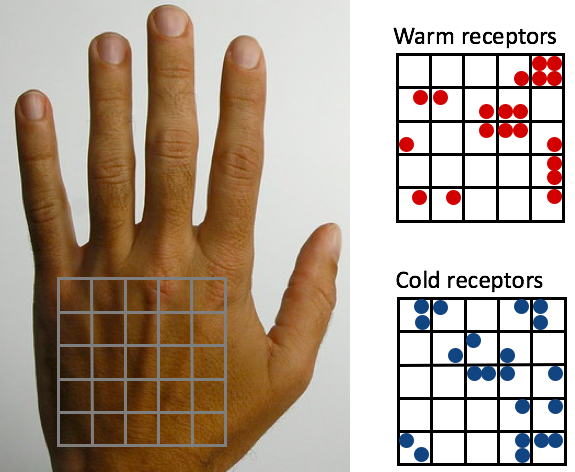Somatosensation
2
Learning Objectives
Know the difference between thermal sensation and thermal nociception.
Know that thermal sensation is carried on thin, unmyelinated axons.
Understand what it means that thermal receptors are not uniformly distributed.
Thermal touch refers to the perception of temperature of objects in contact with the skin. When the hand makes contact with an object, the temperatures of the object and the skin change at a rate that is determined by the thermal properties of the object and skin and their initial temperatures. On the basis of these changes in temperature, people can identify the material composition of objects, for example, whether the object is made from copper or wood. These sensations, however, are not the same as the feeling of being burned by extreme heat (boiling water), or extreme cold (touching dry ice). This experience of pain in relation to temperature is called thermal nociception and involves a different set of distributed receptors.

The number and density of thermoreceptors in the skin has been measured by placing small warm and cold stimulators on the skin and recording the sites at which a person detects a change in temperature. The locations at which a thermal stimulus is detected are known as warm and cold spots and are assumed to mark the receptive fields of underlying thermoreceptors (Fig.2.2.1). Warm and cold spots are only a few millimeters in diameter, and are distributed independently. There are more cold spots than warm spots, and the density of spots varies across the body. For example, on the forearm it is estimated that there are approximately 7 cold spots and 0.24 warm spots per 100 mm2. In addition to differences in the distribution of cold and warm thermoreceptors across the skin surface, the two types of receptor differ with respect to the conduction velocities of the afferent fibers that convey information from the receptor to the central nervous system. Cold afferent fibers are myelinated and so are much faster than unmyelinated warm afferent fibers with conduction velocities of 10-20 m/s as compared to 1-2 m/s for warm fibers. As would be expected from these differences in conduction velocities, the time to respond to a cold stimulus is significantly shorter than that for a warm stimulus. Additionally, the Khan Academy video linked here and included below provides an additional explanation about thermal receptors and thermal nociceptors.
Exercises
CC LICENSED CONTENT, SHARED PREVIOUSLY
“Thermal Touch” by Lynette Jones, MIT
Provided by: Scholarpedia
URL: http://www.scholarpedia.org/article/Thermal_touch.
License: CC BY-NC-SA 3.0

